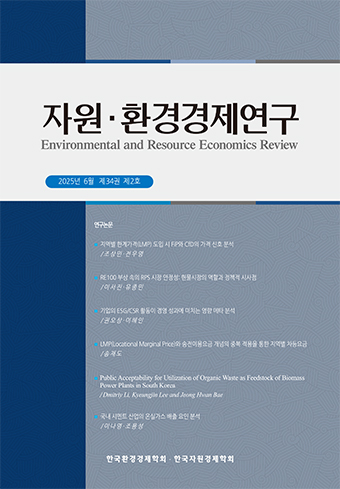Research Paper
Abstract
References
Information
This study examines the determinants of net export of electricity among 30 European countries sharing electricity grid during the period of 1990~2014 by separating the sample period before and after 2005 in which ETS was introduced in Europe. The empirical method used in this study is generalize least squared one considering both heterogeneous and serial correlation in the balanced panel data. According to the empirical results, after 2005 introducing the ETS, holing energy resources, concentrating only on few electricity generation resources, and nuclear electricity generation had played more important role in net export of electricity, while renewable energy had negative effect on net export of electricity and coal and gas generation have no effect on net export after introduction of ETS in Europe probably because of high environmental cost. The policy implication of the results would be that reconsidering each country’s optimal generation mix strategy and its role in case freely trading electricity.
본 연구는 유럽 30개 국가들을 대상으로 1990~2014년 동안의 패널 자료를 이용하여 유럽이 탄소배출권 거래시장을 도입한 2005년을 기준으로 도입 전과 후로 나누어 유럽 내 연결계통국가들의 전력 순수출 변화 결정요인을 이분산과 자기상관 문제를 고려한 패널 GLS 방법으로 추정하였다. 종속변수로는 전력 순수출량이 사용되었으며 설명변수로는 발전원별 발전량 비중, 이웃 국가들의 자국 내 전력수급, 에너지자원 보유국의 전력 생산량, 발전원 집중도 그리고 산업부문의 1인당 총에너지사용량 등을 사용하였다. 추정결과에 의하면, 2005년 이전과 이후 모두에서 에너지자원 보유국의 전력생산량과 발전원 집중도, 원자력 발전비중은 전력 순수출에 통계적으로 유의미하게 양(+)의 영향을 미쳤으며, 탄소배출권 거래제 도입 이후에 그 중요도는 증가하는 것으로 나타났다. 반면 이웃 국가들의 자국 내 전력수급과 산업부문의 1인당 총에너지사용량, 재생에너지 발전비중은 통계적으로 유의하게 음(-)의 영향을 미치는 것으로 추정되었다. 석탄과 가스 발전비중의 경우에는 2005년 이전에만 통계적으로 유의미하게 전력 순수출에 음(-)의 영향을 미쳤다. 본 연구결과는 국가 간 전력교역상황에서 개별 국가들의 역할을 결정하는 요인이 무엇이며 그에 맞는 중·장기 전원믹스 방안을 도출하는 데 시사점을 제시하고 있다.
- 김태현·신한솔·김형태·이성우·한상헌·김욱, “국가간 계통연계가 우리나라 전력계통 운영에 미치는 영향”, 「대한전기학회」, (15/17), 부산대학교, 2015. 7., pp. 253~254.
- 민인식·최필선, 『기초통계와 회귀분석』, 한국STATA학회, 2016b, pp. 58~185.
- 민인식·최필선, 『패널데이터분석STATA』, 한국STATA학회, 2016a, pp. 79~99.
- 박완규·홍성표, 『Gujarati의 계량경제학(개정5판)』, MC Graw-Hill Korea, 2009, pp. 393~397.
- 이성규·김정아, 『이탈리아의 가스시장 특징과 가스허브 구축 전략』, World Energy Market Insight Weekly, 에너지경제연구원, 2018. 7.
- 이성규·정규재, 『동북아 슈퍼그리드 구축사업 관련 해외사례분석과 시사점』, 수시 연구 보고서, 에너지경제연구원, 2018. 2.
- 이현주, “패널 GLS분석을 통한 중국의 전력수요 결정요인 분석”, 「한국동북아경제학회」, 제25권 제3호, 2013. 9., pp. 171~204.
- 전력거래소, 『2017년 해외 전력산업 동향’(유럽연합)』 World Power Market Trend, 2017. 11.
- 한국경제신문, https://www.hankyung.com/international/article/201908129513i.
- 홍승완, 『2017년 해외 전력산업 동향: 이탈리아』, World Power Market Trend Report, 한국전력거래소, 2017. 11.
- Aboumahboub T., Katrin Schaber, Peter Tzscheutschler, Thomas Hamacher, “Optimization of the Utilization of Renewable Energy Sources in the Electricity Sector,” 「Energy & Environment」, ISSN: 1790-5095, 2010, pp. 196~204.
- BP, Stats Review 2005 Full Report, (2005-2016).
- Dassisti, M., and L. Carnimeo, “Net modelling of energy mix among European Countries: A proposal for ruling new scenarios,” Energy, Vol. 39, 2012, pp. 100~111.10.1016/j.energy.2011.07.006
- EU EUROSTAT, https://ec.europa.eu/eurostat/data/database
- European Union, https://europa.eu/european-union/about-eu/countries_en#28members, (2019).
- EWEA(European Wind Energy Association), Occeans of Opportunity: Harnessing Europe’s largest domestic energy resource, September 2009.
- Fuller, B., “The world game: integrative resource utilization planning tool,” World Resources Inventory, 1971.
- Government Offices of Sweden (Ministry of the Environment and Energy), Sweden’s seventh national report under the convention on Nuclear Safety, 2016.
- Greenpeace and 3E, A north sea Electricity Grid[R]evolution: Electricity Output of Interconnected Offshore Wind Power: A vision of Offshore Wind Power Integration, 2008.
- Heide, D., L, Bremen, M. Greiner, C. Hoffmann, M. Speckmann, and S. Bofinger, “Seasonal optimal mix of wind and solar power in a future, highly renewable Europe,” Renewable Energy, Vol. 35, 2010, pp. 2483~2489.10.1016/j.renene.2010.03.012
- IEA, ‘Electricity Information: Overview (2018 Edition)’
- IEA, ‘Key World Energy Statistics 2018’
- IEA, ‘World Energy Balances 2018’
- Schager, K., F. Steinke, P. Muhlich, and T. Hamacher, “Parametric study of variable renewable energy integration in Europe: Advantages and costs of transmission grid extension,” Energy Policy, Vol. 42, 2012, pp. 498~508.10.1016/j.enpol.2011.12.016
- Child, M., C. Kemfert, D. Bogdanov, and C. Breyer, “Flexible electricity generation, gird exchange and storage for the transition to a 100% renewable energy system in Europe,” Renewable Energy, Vol. 139, 2019, pp. 80~101.10.1016/j.renene.2019.02.077
- OECD, https://www.oecd.org/about/members-and-partners/, 2019.
- Schaber, K., F. Steinke, and T. Hamacher, “Transmission grid extensions for the integration of variable renewable energies in Europe: Who benefits where?,” Energy Policy, Vol. 43, 2012, pp. 123~135.10.1016/j.enpol.2011.12.040
- World Nuclear Association, Nuclear Power in Lithuania, May 2017.
- Publisher :Environmental and Resource Economics Review
- Publisher(Ko) :자원 · 환경경제연구
- Journal Title :자원·환경경제연구
- Journal Title(Ko) :Environmental and Resource Economics Review
- Volume : 28
- No :3
- Pages :385~413
- DOI :https://doi.org/10.15266/KEREA.2019.28.3.385



 자원·환경경제연구
자원·환경경제연구






